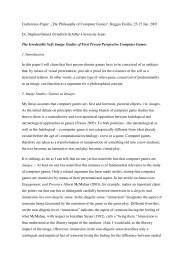Playing Dress-Up: Costumes, roleplay and imagination
Playing Dress-Up: Costumes, roleplay and imagination
Playing Dress-Up: Costumes, roleplay and imagination
Create successful ePaper yourself
Turn your PDF publications into a flip-book with our unique Google optimized e-Paper software.
<strong>Playing</strong> <strong>Dress</strong>-<strong>Up</strong> Ludica<br />
This creates a level of transparency that is not present in other game worlds, <strong>and</strong> has also created a unique<br />
culture of gender play in There.com.<br />
Avatar representation is an issue in all these contexts. Particularly in role-playing games, Taylor remarks<br />
on “the impoverished view of online embodiment most designers seem to be operating with,” especially<br />
where female representation is concerned, noting that many women in her study were forced to bracket or<br />
ignore their discomfort with their avatar appearance. As one of Taylor’s subjects put it: “Who would go<br />
into battle wearing a chain bikini.” (Taylor 2003A pp.37-38) Co-author Pearce has referred to such hyper-<br />
sexualized battle-garb as “kombat lingerie” noting that it reveals a male fantasy about watching women in<br />
battle, rather than a female fantasy of empowerment. (Figure 15) Taylor has also written eloquently about<br />
the power structures of representation in games, a matter that is crying out for further critique. (Taylor<br />
2003B)<br />
Sara Bryant, Virtua Fighter 4 Lara Croft, Tomb Raider Sophitia, Soul Calibur Orchid, Killer Instinct<br />
Figure 15: Examples of Kombat Lingerie<br />
In both Second Life <strong>and</strong> There.com, where clothes are not tied to a race, class or armor stats, fashion<br />
functions primarily as a mode of both individual expression <strong>and</strong> an intersubjective space in which to<br />
explore social identity. Some female players in There.com complain of the “Barbie-doll” style avatar, but<br />
relish the opportunity to have some moderate control over their bust-size, weight, <strong>and</strong> even age. (Pearce<br />
2006B) This differs from the traditional MMOG in that these fashions <strong>and</strong> representations are freely<br />
chosen <strong>and</strong> even designed by the players. With this choice it might be expected that women would veer<br />
away from highly sexualized representations. Conversely, women players <strong>and</strong> designers in both of these<br />
metaverses frequently lean towards much sexier clothing than they would wear in real life, taking<br />
advantage of the freedoms <strong>and</strong> anonymity afforded in a virtual world, as well as the opportunity to inhabit<br />
a “perfect” body (which can highly appealing to those who may feel marginalized in their real bodies).<br />
There.com designers have developed elaborate techniques for rendering cleavage, <strong>and</strong> women in Second<br />
Life frequently present as young, sexy <strong>and</strong> busty.<br />
Philosophy of Computer Games 2007 Page 19






